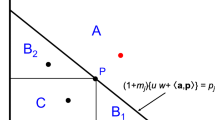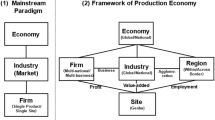Abstract
The vertical scope of a firm, that is, which components or segments of the production processes are kept in–house and which are outsourced, is variously considered as depending on cost and/or technological conditions. Most of the literature focuses on the incentives for an individual firm facing exogenous competition and technological opportunities. In this paper we consider the problem from the perspective of the whole industry: in what respect does firm organizational behavior depend on the industry technological evolution and aggregate structure, and how does innovation and organizational behavior affect the industry structure. We build an evolutionary simulation model of an industry where competitors decide the number of internally produced components. We relate the industry average value of market outsourcing to the technological conditions prevalent in the industry. The results from the model shed light on a number of (apparently) contradictory suggestions in the economic and management literature.




Similar content being viewed by others
Notes
We ignore agency costs, which amounts to assuming that agency costs affect all firms equally and the transaction costs refer to their net effect after agency costs.
Note that we use product component, module and input interchangeably.
Figures available from the authors.
It would be interesting for future work to test where the first peaks (see Fig. 2) would occur in the case of highly integrated and highly modular goods.
See Ciarli et al. (2007a) for an analysis of firms’ technological exploration of ‘complex’ technologies.
References
Abernathy W, Utterback J (1978) Patterns of industrial innovation. Technol Rev 80(7):40–47
Acemoglu D, Aghion P, Griffith R, Zilibotti F (2005) Vertical integration and technology: theory and evidence. CEPR Discussion paper 5258, Centre for economic policy research, London, http://www.cepr.org/pubs/dps/DP5258.asp
Aghion P, Bloom N, Blundell R, Griffith R, Howitt P (2005) Competition and innovation: an inverted–u relationship. Q J Econ 120(2):701–728
Aoki M (1986) Horizontal vs vertical information structure of the firm. Am Econ Rev 76(5):971–983
Bresnahan T, Malerba F (1999) Industrial dynamics and the evolution of firms’ and nations’ competitive capabilities in the world computer industry. In: Mowery D, Nelson R (eds) The source of industrial leadership. Cambridge University Press, Cambridge
Brusoni S, Prencipe A (2001) Unpacking the black box of modularity: technologies, products and organizations. Ind Corp Change 10(1):179–205
Brusoni S, Marengo L, Prencipe A, Valente M (2007) The value and costs of modularity: a problem-solving perspective. Eur Manag Rev 4(2):121–132
Cacciatori E, Jacobides MJ (2005) The dynamic limits of specialization: vertical integration reconsidered. Organ Stud 26(12):1851–1883
Ciarli T, Leoncini R, Montresor S, Valente M (2007a) Innovation and competition in complex environments. Innov Manag Policy Pract 9(3–4):292–310
Ciarli T, Leoncini R, Montresor S, Valente M (2007b) Organisation of industry and innovation dynamics. Working paper 609, Dipartimento Scienze Economiche, Università di Bologna, Bologna, http://www2.dse.unibo.it/wp/609.pdf
Coase RH (1937) The nature of the firm. Economica 4(16):386–405
Coase RH (1992) The institutional structure of production. Am Econ Rev 82(4):713–719
David P, Greenstein S (1990) The economics of compatibility standards: an introduction of recent research. Econ Innov New Technol 1(1–2):3–41
Dosi G, Marengo L (2002) On the tangled discourse between transaction cost economics and competence-based views of the firm. In: Foss N, Mahnke V (eds) Competence, governance, and entrepreneurship advances in economic strategy research, chap 4. Oxford University Press, Oxford
Dosi G, Nelson RR, Winter SG (2000) The nature and dynamics of organizational capabilities. Oxford University Press, Oxford
Ernst D (2005) Limits to modularity: reflections on recent developments in chip design. Ind Innov 12(3):303–305
Foss N (1993) Theories of the firm: contractual and competence perspective. J Evol Econ 3(2):127–145
Jacobides MJ, Winter SG (2005) The co-evolution of capabilites and transaction costs: explaining the institutional structure of production. Strateg Manage J 26(5):395–413
Kauffman SA, Lobo J, Macready WG (2000) Optimal search on a technology landscape. J Econ Behav Organ 43(2):141–166
Klepper S (1997) Industry life cycles. Ind Corp Change 6(1):145–182
Klepper S, Thompson P (2006) Submarkets and the evolution of market structure. Rand J Econ 37(4):861–886
Lancaster KJ (1966) A new approach to consumer theory. J Polit Econ 74(2):132–157
Langlois RN (1992) Transaction cost economics in real time. Ind Corp Change 1(1):99–127
Mahnke V (2001) The process of vertical dis-integration: an evolutionary perspective on outsourcing. J Manag Gov 5(3–4):353–379
Malerba F, Nelson RR, Orsenigo L, Winter SG (1999) History-friendly’ models of industry evolution: the computer industry. Ind Corp Change 8(1):3–40
Marengo L, Dosi G (2005) Division of labor, organizational coordination and market mechanisms in collective problem-solving. J Econ Behav Organ 58(2):303–326
Marengo L, Dosi G, Legrenzi P, Pasquali G (2000) The structure of problem-solving knowledge and the structure of organisations. Ind Corp Change 9(4):757–788
Nelson RR, Winter SG (1982) An evolutionary theory of economic change. The Belknap Press of Harvard University Press, Cambridge, MA
Richardson GB (1972) The organisation of industry. Econ J 82(327):883–896
Robertson PL, Langlois RN (1995) Innovation, networks, and vertical integration. Res Policy 24(4):543–562
Simon HA (1969) The sciences of the artificial. MIT, Cambridge, MA
Utterback J, Abernathy W (1975) A dynamic model of process and product innovation. Omega 3(6):639–656
Valente M (2006) Pseudo–NK: an enhanced model of complexity. Discussion paper, University of L’Aquila
Williamson O (1975) Markets and hierarchies: analysis and antitrust implications. Free Press, New York
Author information
Authors and Affiliations
Corresponding author
Additional information
Previous versions of the paper, with differing titles, were presented at the Wehia 2006, 1st International Conference, Bologna; the International Schumpeter Society 11th ISS Conference, Sophia–Antipolis; and the SPRU 40th Anniversary Conference, at Brighton. We are grateful to conference participants for helpful comments and critiques, in particular Robin Cowan, Gerald Silverberg and Bo Carlsson. Comments from Luigi Marengo and two anonymous referees were very helpful in enabling us to improve the quality of the paper. Leoncini and Montresor acknowledge financial support from the PRIN project ‘Fragmentation and Local Development’, University of Bologna. The usual disclaimers apply.
Rights and permissions
About this article
Cite this article
Ciarli, T., Leoncini, R., Montresor, S. et al. Technological change and the vertical organization of industries. J Evol Econ 18, 367–387 (2008). https://doi.org/10.1007/s00191-008-0092-x
Published:
Issue Date:
DOI: https://doi.org/10.1007/s00191-008-0092-x




